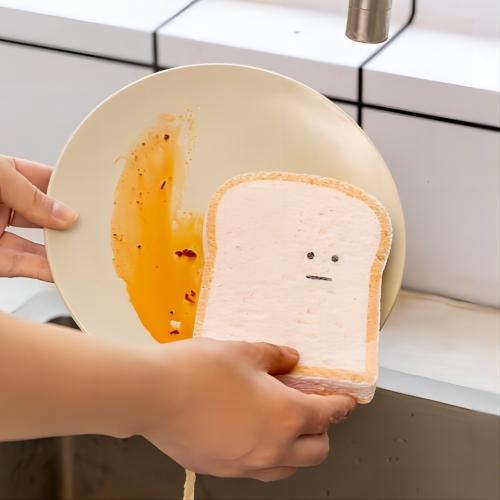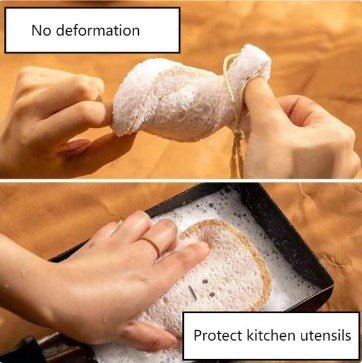Although sponges are effective in keeping homes clean and tidy, they pose a risk to the environment. This is because many cleaning sponges are made of nonbiodegradable plastic, meaning that after only a few weeks of use, they will remain in landfills for hundreds of years. Thankfully, there are alternatives available that can help you maintain a clean home without harming the planet.
By using cellulose sponges, you can easily absorb spills while being mindful of the environment, as they are made of biodegradable materials.
An Absorbing History
Sponges possess pores that absorb and retain water until they are squeezed out. These versatile cleaning tools have been utilized in various capacities since ancient times, with the original versions being harvested from the sea. The use of animal sponges ranged from cleaning to even serving as a tampon. In ancient Rome, sponges were tied to sticks and employed as toilet paper. However, due to the slow growth rate of these natural sponges, demand often exceeded supply. This issue was resolved with the invention of synthetic sponges. While there is some debate about the origins of foam sponges, some sources claim that a German scientist accidentally invented them in 1937, while others assert that Du Pont created the first synthetic sponge comprising of cellulose, sodium sulphate, and hemp fiber in the 1940s. Regardless of their exact inception, the production of manufactured sponges provided a cheaper and more accessible alternative to the harvested sea sponges.
What Is a Cellulose Sponge?
As its name suggests, a cellulose sponge is primarily composed of cellulose, the same material that constructs the walls of plant cells. Hemp fibers and sodium sulfate crystals are also added to the mixture. The resulting product is heated up, cut to size, bleached, and rinsed before use. One major advantage of using cellulose sponges is their biodegradable nature due to their composition of plant-based fibers. It is crucial to check that the cellulose sponge purchased does not contain any non-biodegradable synthetic materials to ensure adequate protection of the environment.
One issue associated with cellulose sponges is their tendency to absorb food particles and harbor germs due to being composed of natural materials. Additionally, as all sponges are designed to absorb substances, they tend to trap bacteria in the process. For this reason, it is crucial to regularly disinfect and replace sponges frequently, especially those utilized in the kitchen to prevent the spread of harmful bacteria and keep a hygienic environment.
Sponge Safety
To ensure that your sponges are free of harmful bacteria, it is essential to keep in mind the following tips:
Use different sponges for different jobs:
It is obvious that sponges utilized in the kitchen should be kept separate from those used in the bathroom. However, it is also advisable to assign different tasks to various kitchen sponges. For instance, the sponge employed in wiping up spills on kitchen counters should not be the same one used for washing dishes. When cleaning up meat or poultry juices, it is best to use paper towels to avoid cross-contamination and maintain a clean and safe environment.
Clean sponges regularly:
Once you're finished using a sponge, ensure that all food particles are rinsed out, and the sponge is left to dry completely. It's crucial to give the sponge a thorough cleansing on a daily basis, despite it being time-consuming. Daily sanitization can protect your health by preventing the spread of food-borne bacteria and prolong the life of the sponge, resulting in less waste. If daily cleaning seems too arduous, aim for a weekly deep cleanse at minimum.
How do you clean a cellulose sponge? There are a number of ways:
• Soak a sponge in a solution of one part bleach and nine parts water for a few minutes. Ensure that the sponge is wrung out and left to air dry afterward. In one study, this technique effectively eliminated 99.9% of three types of bacteria, meeting the Environmental Protection Agency's standards.
• Saturate a cellulose sponge with approximately 1/2 cup of water and heat it on high in the microwave for about 30 seconds. Always check if your sponge has any metallic scrubbing material attached to it and monitor it closely as sponges might catch fire.
• Soak the sponge in full-strength vinegar for five minutes, then rinse thoroughly.
• Wash the sponge in a washing machine with a load of white laundry, ensuring that you add bleach to the cycle.
• If you have a dishwasher, add your sponge to a load of dishes and set the machine to its highest temperature setting.
Replace frequently:
If you sanitize your sponges daily, they can last for up to a month, according to some experts. However, if you fail to do so, it is advisable to replace them every one to two weeks. It is imperative to dispose of any sponge that has a foul smell (as this indicates the presence of bacteria), visible food particles that refuse to be removed, or visible signs of wear and tear. If you have been using a kitchen cleaning sponge for several weeks and it appears to be in good condition, consider moving it to be used for bathroom cleaning duties instead.
Cute Toast Cellulose Sponge UNEEDE Kitchen Sponge and Scrubber Sponge








Leave a comment
All comments are moderated before being published.
This site is protected by hCaptcha and the hCaptcha Privacy Policy and Terms of Service apply.